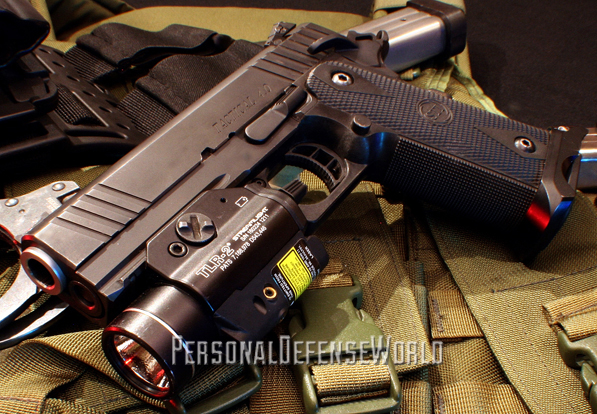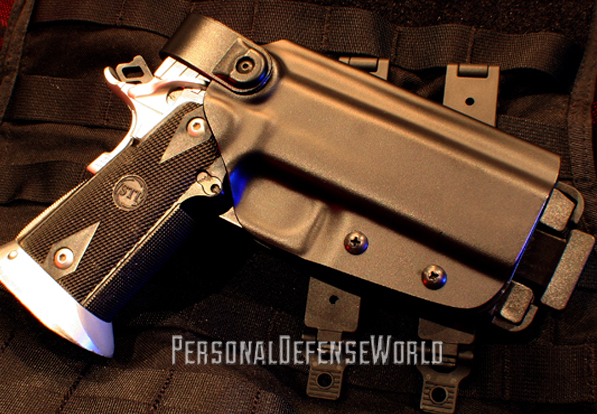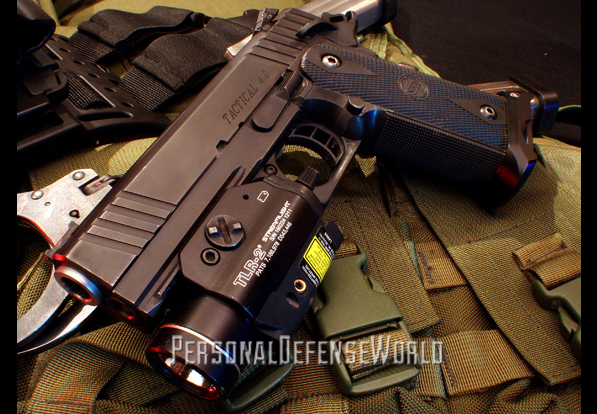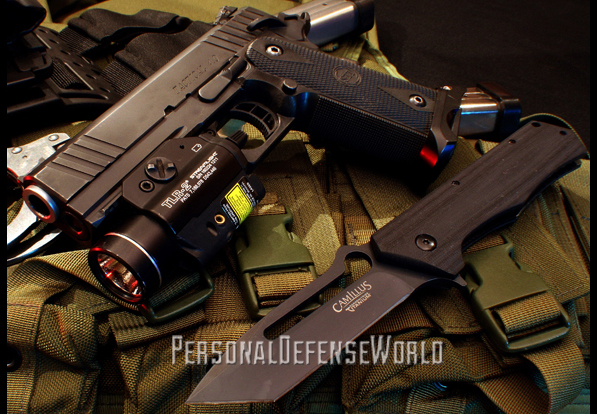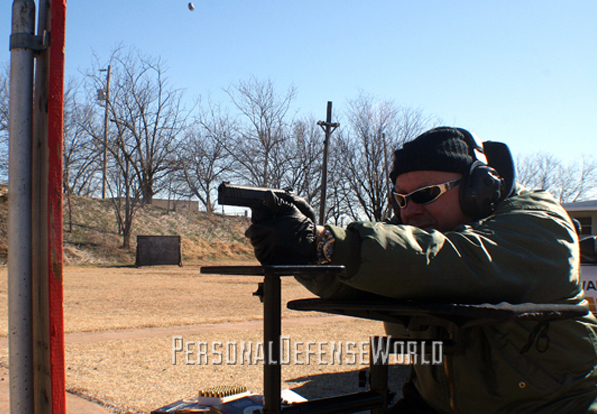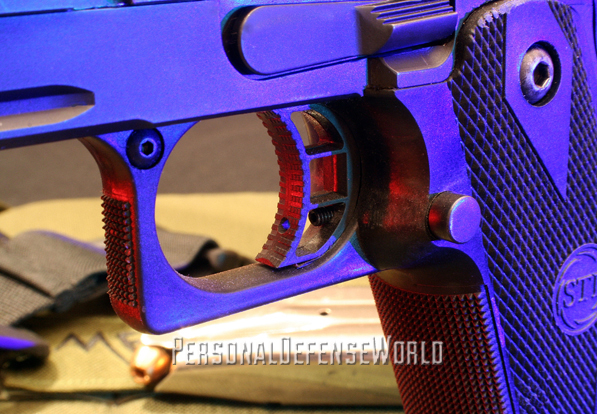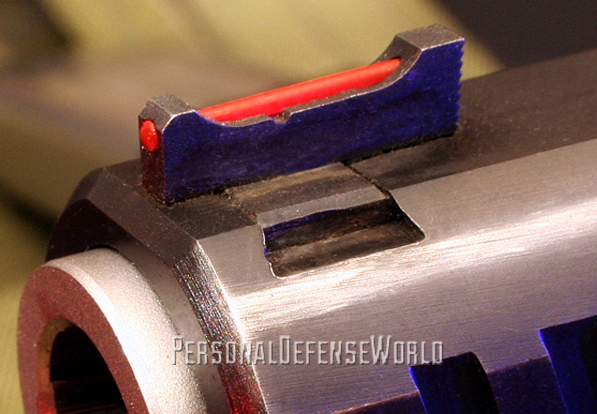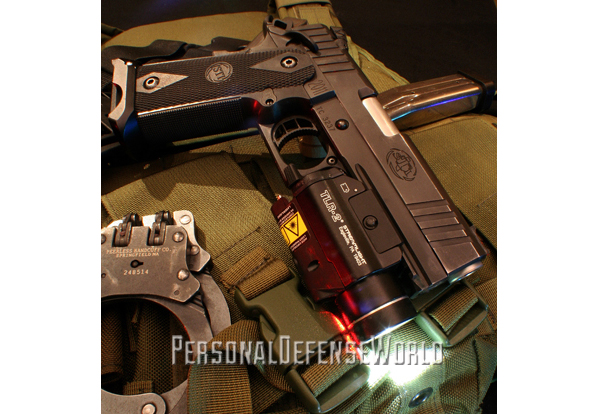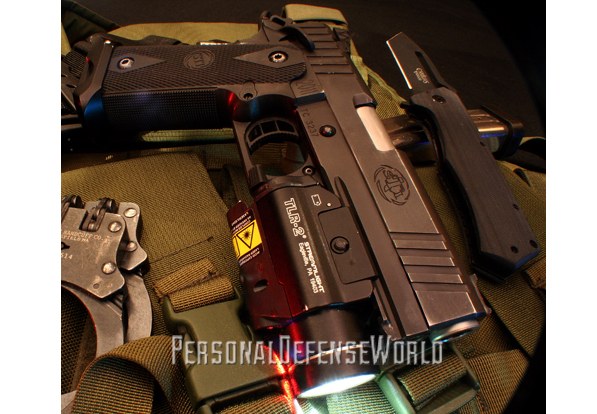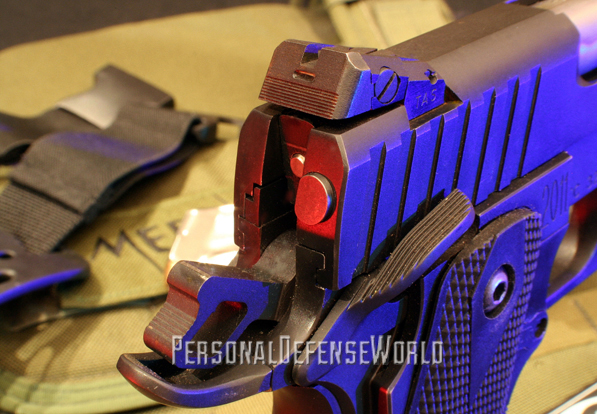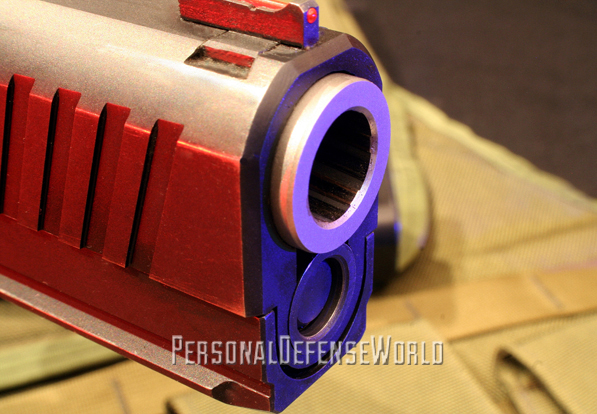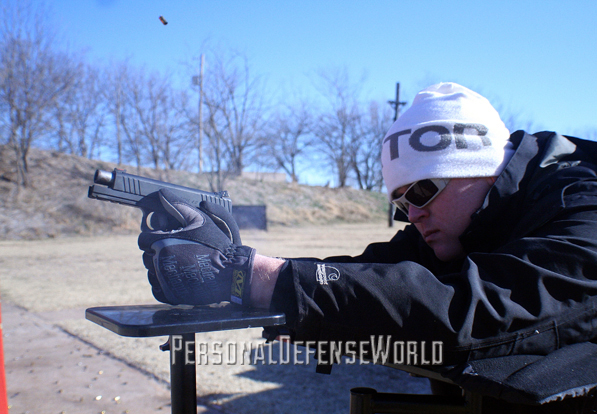Built to exceptionally tight tolerances, the STI Tactical 4.0 offers custom-grade enhancements, a double-stack frame and top-notch accuracy.
As a full-time patrol officer, I’ve carried STI’s Tactical 4.15 pistol both on and off-duty for the past five years, so I’ve definitely developed an affinity for the Texas-based company. The Tactical has proven to be rugged and reliable for me on duty, with above-average features and utility. If you haven’t fired one of STI’s pistols built on the company’s modular 2011 frame, I suggest you give it a try. It’s far leaner in the grip area than one would expect for a pistol with such a magazine capacity. I’ve even had Glock shooters remark that the grip circumference was less than they’d expected.
It’s only natural then that I keep my ear to the ground for new developments from my friends at STI, not only in the Tactical line of pistols, but throughout the various other offerings from the firm.
Advertisement — Continue Reading Below
STI has added a few models to the Tactical line, and what was once known as the Tactical 4.15 has been changed to the STI Tactical 4.0, which I think was intended to simplify the models, as the dimensions have remained the same. New also is the Tactical 3.0 model, which features the same 2011 grip frame and capacity, albeit with a 3.75-inch barrel.
At the heart of the Tactical 4.0 is its 4.26-inch bull barrel, made from a 416R rifle-grade stainless steel forging that is ramped and fully supported. It has button-broached rifling with a 1-in-16-inch twist rate, and the crown is cut at a 45-degree angle.
The slide is machined from 4140 carbon steel, and it has deeply cut cocking serrations at the rear, a flat top and a slight bevel up front. The ejection port is lowered and flared. For aiming, the Tactical 4.0 has an STI ramped front blade and a fixed Novak-style rear sight. Both are serrated. However, I ordered my test pistol with a fiber-optic front
and STI’s own Tactical Adjustable Sight (TAS) rear with tritium. The tritium is installed in the configuration of a hori-zontal bar under the notch of the sight. Two-dot night sights are also optional.
Advertisement — Continue Reading Below
The Tactical 4.0’s frame is also machined from 4140 carbon steel, and it features the excellent 2011 modular design—born of and having received its baptism of fire in competition sports—with an integral accessory rail and a full-length dust cover. They also offer a version with an aluminum frame, called the Tactical Lite 4.0. The slide stop is a standard serrated GI type. The gun is also fitted with what I like to call an ambidextrous “gas pedal”-style serrated thumb safety. An STI high-ride beavertail with a memory bump is blended to the frame, and the hammer features the company’s squared, roweled spur.
The grips sports double-diamond checkering, are made of glass-filled nylon polymer—a molded nylon polymer material interlaced with strands of glass for added strength. The frontstrap features 20-lines-per-inch (lpi) checkering, which pairs nicely with the 25-lpi checkering on the squared face of the triggerguard. The junction of the frame and triggerguard is undercut to facilitate a high hold on the pistol. The pistol also utilizes a long, curved, glass-filled nylon trigger. The mag release is a smooth button—extended, but not overdone.
Gone is the aluminum tactical magazine well that was formerly standard on the 4.15, though it can be ordered
from a supplier and retrofitted. Person-ally, I like it, as it is quite functional on my original Tactical, and I manage to conceal it fine. I ordered a tactical magazine well with my pistol, and later fixed it to the grip via the mainspring-housing pin. A minor change has been made to the newer magazine well: a half-crescent notch is cut into its bottom at both sides. This allows the shooter to manually strip the flush magazine from the gun in the event of a “Stage 2” malfunction (which I’ve never encountered with one of STI’s pistols). It also has a lanyard loop attachment hole at the rear.
Advertisement — Continue Reading Below
Other than the obvious double-stacked frame, these guns have a number of attributes that make them better than the competition, and closer to being “semi-custom,” rather than strictly mass-produced. According to STI, the com-pany’s tolerances are tighter than others; STI uses superior materials, its guns are backed by a lifetime warranty, and since the company is actually owned by its employees, there is a strong personal stake invested in its finished products.
In an age where metal-injection-molded (MIM) parts have become an industry standard, STI uses this cost-cutting process only in its safeties. The extractor is made of tool steel. Other critical parts, such as the hammer and sear, are made from electronic-discharge machining (EDM)—very good stuff. The slide stop is 4140 carbon steel. Further, all of the parts in an STI pistol are hand-fitted by the company’s smiths, not “dropped in” with “close enough” tolerances.
The 2011 design’s features contribute to the shooting qualities of STI’s pistols. For instance, the very fact that the gun has all of that steel up top and out front, with a lightweight grip frame at the bottom rear, means that muzzle flip is dampened by way of weight distribution. Further controlling recoil, muzzle flip and muzzle dip is the RecoilMaster guide
rod. Key to this innovative system is its dual-spring system, which lasts ten times as long as a conventional single spring. It also provides for softer recoil, a longer slide dwell time to allow magazine springs to react, a faster recovery time and less muzzle dip.
Advertisement — Continue Reading Below
When a conventional recoil spring slams a slide into battery, its inertia pulls the frame forward. Since the rear of the gun is anchored by the shooter’s hand, the muzzle necessarily dips down. The RecoilMaster dual-spring system overcomes this by virtue of its primary spring having been computer-designed to expend the bulk of its kinetic energy in the act of stripping the next round from the magazine. The secondary spring is designed to allow the slide to “coast” into battery with only 3 to 4 pounds of force remaining in the unit rather than the 12- to 18-pound spring normally used. This eliminates the slam, and thereby the resultant dip.
Other polymer-framed pistols are known to have a mushy trigger pull and diminished accuracy due to the frame flexing during the pull and recoil. The STI design negates this effect since the frame (housing the ignition set and rails) is rigid steel, while on the other hand, the polymer grips’ flex serves to buffer felt recoil.
Rounds Downrange
I gathered up offerings in ammunition from Asym, Federal, Hornady and Speer and headed to the range to see
how the Tactical 4.0 would perform. I set up paper target backings and affixed some adhesive targets to the paper. Bench-resting the pistol, I began firing five-shot groups from 25 yards to establish the STI’s potential for accu-racy. I was assisted by SWAT and K9 Officer Evan Rockenfield.
Advertisement — Continue Reading Below
The best group of the day, produced by Hornady’s 185-grain FTX load, measured just 2.94 inches center to center. Next came Asym’s 230-grain Match FMJ load with a 3.31-inch cluster. Federal’s 230-grain HST load funneled into 3.63 inches. Speer’s Lawman 200-grain TMJ followed this with a 3.81-inch group.
Officer Rockenfield want-ed to try our state pistol qualification course with the Tactical 4.0, which involves firing strings from 25 yards to 3 yards, scoring a 96 percent on the first attempt. (One round outside of the scoring rings.) The rounds were so tightly placed that Evan could almost completely cover the pattern in the chest area with his hand.
The trigger had less than a millimeter of take-up, breaking crisply at 4 pounds with no overtravel. Fit and finish were excellent. There was no play between the slide and frame, and the barrel locked up solidly when the pistol was in battery. This gun was super-tight, like all of the STI pistols I’ve tested. It seems that, for this reason, most STIs do well with a break-in period. The Tactical 4.0 was no exception, as during our tests it would occasionally (rarely) fail to go fully into battery when using FMJs (which are longer), at which time a rap to the magazine always sent the slide home. After a few hundred rounds, things smoothed up and the ammunition cycled well. After a thorough cleaning and lube, during a return session to the range, things were completely different: the gun fired all rounds smoothly without a single failure.
Advertisement — Continue Reading Below
The RecoilMaster doesn’t at first seem to dampen felt recoil much, but turns it into more of a “push” then a flip of the muzzle, hence the gun was quite controllable during rapid fire. Our only complaint was that a proprietary cut to the normally round contour of the beavertail on both sides has a slightly squared edge, which became uncomfortable during our extensive sessions. The cut is there to let the gun sit a bit deeper in the hand by narrowing the tang, and it’s effective in that regard—a simple breaking of those edges would do the trick. A memory bump on the beavertail allowed trouble-free shooting even with a high thumb position.
Final Notes
STI seems to just get better as time goes by, and that’s the way makers of fine firearms should be. The aluminum mag well has been deleted from the pistol as a standard feature, most likely due to customer feedback. This makes the Tactical 4.0 easier to conceal. Personally, I appreciate the utility of the magazine well.
A new Tactical 3.0 is also a welcomed addition to the line; it would be the ideal version of the Tactical for carry, either for self-defense or perhaps for those serving on a personal-protection detail.
Advertisement — Continue Reading Below
The Tactical 4.0 has great balance, and is quicker out of the holster and quicker on target than a full-sized gun. It proved accurate and reliable after a break-in period, and it was a comfortable shooter, with the exception of the unique cut to the beavertail mentioned previously, which only becomes a bother during extensive shooting sessions. In fact, if you’re after a double-stacked tactical pistol and haven’t tried one of STI’s 2011s, you’re in for a treat. The high hold that the design allows through optimal contouring of the frame provides superior control. Further, the grip frame itself is substantially narrower than any other full-capacity pistol out there. Lastly, the STI is certainly noticeably lighter than any of the steel double-stacked 1911s on the market.
In the end, STI’s Tactical 4.0 is a great pistol, affording the shooter tight tolerances, great accuracy, a barrage
of big-bore firepower, attachment of tactical lighting accessories and steady dependability after an initial break-in period. For more information, visit stiguns.com or call 512-819-0656.
BUY NOW! AT www.personaldefenseworld.com/subscribe/handguns-buyers-guide/.
Advertisement — Continue Reading Below
